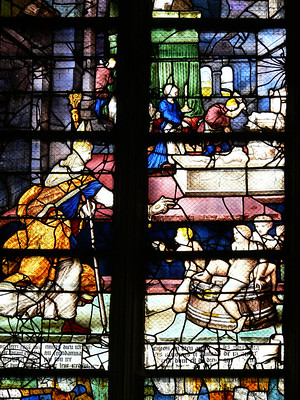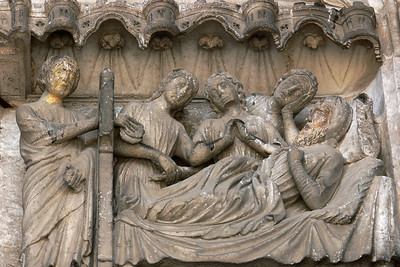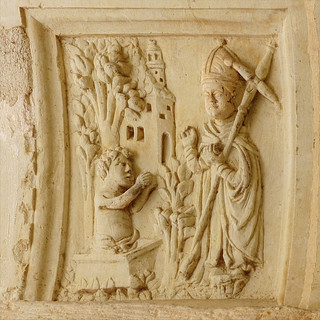The Legends of St. Nicholas: The Three Boys and the Dowries
The Miracle of the Three Boys

The story of St. Nicholas and the three boys, often called “The Miracle of the Three Pickled Boys” or “The Three Children Resurrected from the Pickling Vat”, is one of the most enduring and vivid legends of the saint’s medieval cult. In this tale, St. Nicholas revives three boys (or students) who were murdered by a wicked innkeeper or butcher during a time of famine. Their bodies, dismembered and salted in a barrel, were intended to be sold as meat. Through Nicholas’s prayers, the boys are miraculously restored to life. This legend cemented Nicholas’s role as the patron saint of children and became a central episode in his vita (life story).
The earliest known written version of the story appears in the 12th century, around 1137, in the De santicis ecclesiae Mettensis (“On the Saints of the Church of Metz”), composed by an anonymous monk at the Abbey of Saint-Pierre-aux-Nonnains in Metz, France. In this version, the victims are three theological students traveling to Athens, who are drugged, killed, and dismembered by an innkeeper, then salted in a tub. St. Nicholas, discovering the crime, resurrects them through his prayers. The text records: “Tres clerici... interfecti et in dolio salsi... a sancto Nicholao resuscitati”, “Three clerics... killed and salted in a tub... resurrected by St. Nicholas.”
Originally, the victims were portrayed as clerics or students, reflecting medieval anxieties about scholars’ safety while traveling. Over time, the narrative shifted: by the early 13th century, particularly in France and Western Europe, the victims came to be imagined as young children, emphasizing Nicholas’s compassion for the innocent. This evolution is evident in hagiographic collections such as Jacobus de Voragine’s Legenda Aurea (Golden Legend, c. 1260), where the gruesome image of the pickled boys became firmly established in both art and liturgy.
The story’s popularity spread through Robert Wace’s Vie de Saint Nicolas (c. 1150–1170), which helped integrate it into the broader French vernacular tradition. Wace’s poetic retelling blended elements from other miracle tales, notably that of a murdered merchant. From this period onward, the “children in the barrel” became one of the most recognizable iconographic attributes of St. Nicholas across Western Europe.
In France, a charming folkloric development recast the wicked butcher as St. Nicholas’s repentant servant, who follows him thereafter, a figure that would later inspire Père Fouettard in French Christmas lore. The story also gave rise to one of France’s most beloved songs, and the image of St. Nicholas with three children in a tub at his feet became the most widespread representation of the saint in Western European art from the 14th century onward.
The earliest known artistic depiction of this miracle appears in a historiated initial in the Stowe Breviary (c. 1322–1325, British Library, Norwich), showing Nicholas raising the boys from the vat, an image later echoed in stained glass, sculpture, and manuscript illumination.
The Miracle of the Three Dowries
Another of St. Nicholas’s most celebrated miracles, the Gift of the Dowries, underscores his compassion and generosity, particularly toward the poor and vulnerable. This legend tells how Nicholas secretly provided dowries for three impoverished daughters of a nobleman, saving them from destitution or prostitution.

In the story, a once-wealthy man, unable to marry off his daughters due to poverty, faces despair. Learning of their plight, Nicholas secretly intervenes. On three successive nights, he throws a bag of gold coins through the family’s window (or, in later versions, down the chimney), providing each girl with a dowry. In some tellings, the gold lands in stockings or shoes left by the fire, an image that later inspired European Christmas gift-giving traditions. When the father finally catches Nicholas in the act, the saint insists on secrecy, exemplifying humility and anonymous charity.
This story appears in written form by the 9th century, found in early Greek and Latin vitae of the saint, such as those compiled by Methodius, Patriarch of Constantinople (c. 843–847). It is later retold in Symeon Metaphrastes’s Vita per Metaphrasten (10th century), one of the most influential Byzantine sources. The tale reached the Latin West by the 11th century, appearing in texts like the Codex Vossianus Latinus (Leiden University Library).
The legend became canonical through Jacobus de Voragine’s Legenda Aurea (c. 1260), which disseminated it throughout medieval Europe. The dowry miracle reflects Byzantine social concerns about poverty and women’s vulnerability, while its Western transmission emphasized Christian charity and social justice.

In visual representations of the Dowry Miracle, St Nicholas is almost always shown giving the gift of gold to the father rather than to the daughters, even in scenes where the daughters are present. The Chartres north porch provides a classic example: the three girls stand at the foot of the bed, but the purse is deliberately directed toward the father, whose moral peril and repentance form the heart of the narrative. This compositional logic—Nicholas → father → daughters (indirectly)—appears consistently across medieval sculpture, manuscript illumination, and stained glass.
Theologically, the tale expresses three core virtues of Nicholas’s cult:
Charity , aiding those in need without seeking recognition.
Protection , safeguarding the innocent and marginalized.
Humility , acting selflessly for the sake of others.
Over time, this story profoundly shaped St. Nicholas’s transformation into a gift-bringer, commemorated on December 6 (St. Nicholas Day), and ultimately influenced the evolution of Santa Claus traditions in Western Europe.
Summary
Together, these two legends, the Miracle of the Three Boys and the Gift of the Dowries, capture the dual essence of St. Nicholas’s sanctity: his miraculous power to restore life and his compassionate care for the poor. Both stories, rooted in Byzantine piety and Western adaptation, shaped his image as the protector of children, the poor, and the innocent, securing his enduring place as one of Christianity’s most beloved saints.
- 1. Stained Glass, Cathedral of Saint-Étienne, Beauvais c. 1520–1530 In this richly detailed Renaissance window, St. Nicholas blesses the three boys rising from the barrel, while behind him the wicked innkeeper and his wife recoil in horror. The domestic setting and expressive gestures mark a stylistic shift toward human drama and spatial realism, typical of Beauvais glass workshops of the early 16th century. This scene fuses Gothic devotion with Renaissance naturalism, illustrating Nicholas’s mercy and divine intervention.
- 2. Stone relief, South Portal, Chartres Cathedral c. 1210–1220
This early Gothic sculpture captures St. Nicholas secretly providing dowries to three impoverished daughters of a sleeping nobleman. The saint, standing at left with his crozier, extends a purse of gold toward the reclining father, while the three young women sit beside the bed in graceful poses of gratitude and modesty. The scene conveys themes of charity and humility, aligning with the saint’s reputation as a benefactor of the poor. Executed with characteristic Chartres elegance, elongated figures, rhythmic drapery, and serene expressions, it embodies the spiritual compassion central to Nicholas’s cult. - 3. The Fontevraud reliefs follow this established pattern, depicting Nicholas approaching a male figure at a window, with the daughters omitted entirely. In a monastic setting such as Fontevraud, this focus on the father’s transformation is both theologically precise and visually practical: it preserves the moral clarity of the story while avoiding unnecessary narrative complexity or ambiguous treatment of young women in a cloister context.
